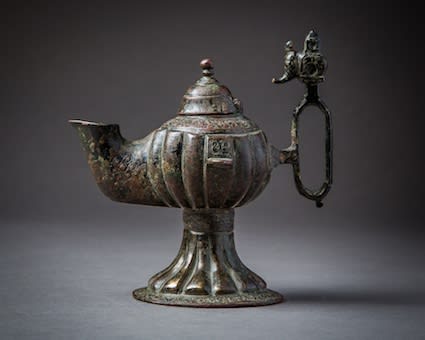Bronze Oil Lamp with Silver Inlay, 11th Century CE - 13th Century CE
Bronze and Silver
14 x 13 cm
5 1/2 x 5 1/8 in
5 1/2 x 5 1/8 in
JB.1240
Cast, bronze oil lamp with silver inlay, chased and punched decoration; spherical, fluted body standing upon tall, splayed foot, similarly fluted; short spout with nozzle flanked by pseudo-volutes; high, openwork...
Cast, bronze oil lamp with silver inlay, chased and punched decoration; spherical, fluted body standing upon tall, splayed foot, similarly fluted; short spout with nozzle flanked by pseudo-volutes; high, openwork handle with elephant terminal; central pouring hole covered by hinged lid; small, lug handle on either side of body; decoration consists of silver inlay Kufic inscription to shoulder; arabesque registers to body and base; silver inlay rosette on either side of spout.
This beautiful piece of metalwork stems from a period of great transition in Central Asia, an historical region that today denotes Kazakhstan, Kyrgyzstan, Tajikistan, Turkmenistan and Uzbekistan.
Central Asia prospered after the advent of Islam in 7th Century ACE; crisscrossed by trade routes that connected Muslim lands with the people of Europe, India and China, the region flourished as a hub of world culture. From around 10th Century ACE however we see a period of decline, which lasted up until the Mongols came into power during 13th Century ACE.
This political vista was defined by great power transfers that divided the region into several semi-autonomous states. Naturally, this circumstance had repercussions in art and we see influence across a vast area, both contemporary and pre-Islamic.
Rather than ignoring the traditions of the cultures they encountered, artisans took inspiration and carried metalwork to new heights by working in new forms and techniques.
Form, material and decorative techniques were appropriated from classical techniques transmitted to Islam by Late Roman and Byzantine sources. In this case, the openwork handle, rosettes, pseudo-volutes and fluting all mimic Byzantine lamps.
The technique of silver inlay was still a relatively new praxis at this time, having been established during 12th century. The inscription has been abstracted to an almost unintelligible level fulfilling a prevalent desire for abstract forms. The choice of Arabic denotes a desire to emulate the preceding Arab states.
The use of animal imagery is prolific at this time, though depictions of elephants are rather rare and may be have been inspired by some eastern influence. The floral shape of the vessel may also point to Indian influence.
While, depictions of elephants are scant in Islamic art, a small cast bronze elephant and cup with an elephant on the handle have both been found from regions in Central Asia during 10th-11th centuries, emphasising the influence of Buddhist image-producing workshops.
This beautiful piece of metalwork stems from a period of great transition in Central Asia, an historical region that today denotes Kazakhstan, Kyrgyzstan, Tajikistan, Turkmenistan and Uzbekistan.
Central Asia prospered after the advent of Islam in 7th Century ACE; crisscrossed by trade routes that connected Muslim lands with the people of Europe, India and China, the region flourished as a hub of world culture. From around 10th Century ACE however we see a period of decline, which lasted up until the Mongols came into power during 13th Century ACE.
This political vista was defined by great power transfers that divided the region into several semi-autonomous states. Naturally, this circumstance had repercussions in art and we see influence across a vast area, both contemporary and pre-Islamic.
Rather than ignoring the traditions of the cultures they encountered, artisans took inspiration and carried metalwork to new heights by working in new forms and techniques.
Form, material and decorative techniques were appropriated from classical techniques transmitted to Islam by Late Roman and Byzantine sources. In this case, the openwork handle, rosettes, pseudo-volutes and fluting all mimic Byzantine lamps.
The technique of silver inlay was still a relatively new praxis at this time, having been established during 12th century. The inscription has been abstracted to an almost unintelligible level fulfilling a prevalent desire for abstract forms. The choice of Arabic denotes a desire to emulate the preceding Arab states.
The use of animal imagery is prolific at this time, though depictions of elephants are rather rare and may be have been inspired by some eastern influence. The floral shape of the vessel may also point to Indian influence.
While, depictions of elephants are scant in Islamic art, a small cast bronze elephant and cup with an elephant on the handle have both been found from regions in Central Asia during 10th-11th centuries, emphasising the influence of Buddhist image-producing workshops.



